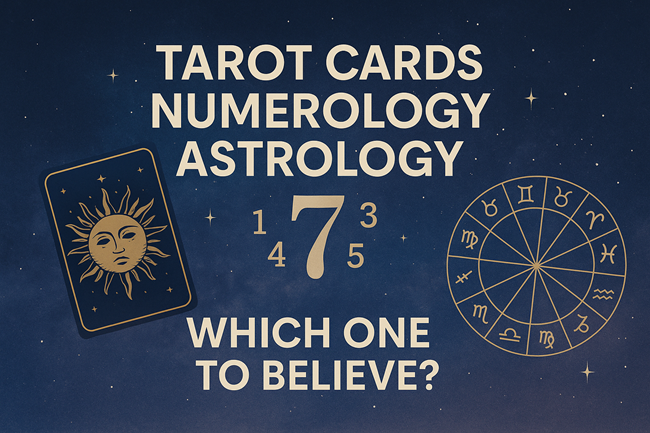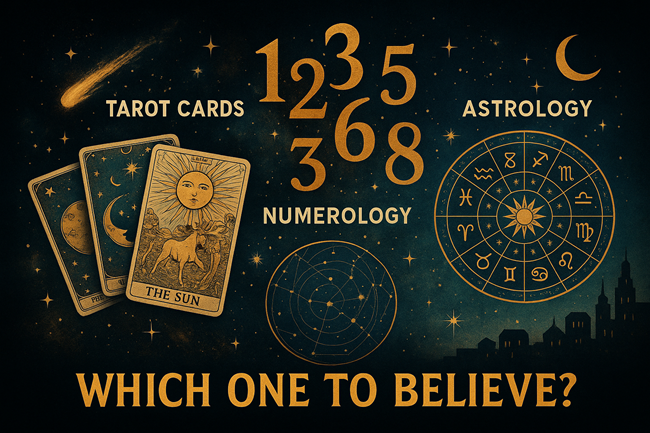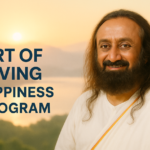Ancient Wisdom, Modern Curiosity
In today’s fast-paced world filled with uncertainty, many people turn toward ancient practices to find answers, peace, and direction. Tarot Cards vs Numerology vs Astrology have become popular mediums for spiritual guidance.
But which one should you trust? What’s the difference between them? And how does one become an expert in these fields?
Let’s dive into the origins, methods, popularity, and beliefs behind each of these mystical sciences so you can make an informed choice.

Tarot Cards vs Numerology vs Astrology
1. Tarot Cards: Symbolic Insight Through Intuition
Origin
- Originated in the 15th century in Europe.
- Evolved from playing cards into a spiritual tool by the 18th century.
How It Works
- A 78-card deck divided into Major Arcana and Minor Arcana.
- Readers interpret symbols and archetypes to gain emotional and intuitive insight.
Popular Regions
- USA, UK, France, and increasingly in urban India via social media and wellness platforms.
How to Master
- Learn card meanings.
- Practice intuitive spreads.
- Study from trusted authors and take mentorship courses.
Best For
- Emotional healing, daily guidance, and self-awareness.
2. Numerology: The Science of Numbers
Origin
- Ancient Egypt and Babylon, formalized by Greek philosopher Pythagoras.
How It Works
- Converts your name and date of birth into key numbers like Life Path, Destiny, and Soul Urge.
- Each number carries meaning and vibrational energy.
Popular Regions
- Global use in India, China, USA — especially for business names and baby naming.
How to Master
- Study number patterns and charts.
- Learn Chaldean and Pythagorean methods.
- Analyze real-life examples for accuracy.
Best For
- Personality decoding, destiny analysis, compatibility checks.
3. Astrology: The Cosmic Blueprint
Origin
- Over 5,000 years old, rooted in Indian, Greek, and Babylonian cultures.
- In India, known for Kundli, planetary doshas, and Vedic wisdom.
How It Works
- Based on the position of planets at your time of birth.
- Uses birth charts, houses, and transits to map life patterns.
Popular Regions
- Deeply followed in India, Nepal, and gaining traction in the West.
- Used for marriage, health, career, and timing events.
How to Master
- Learn to read charts.
- Study planetary combinations (yogas).
- Use astrology tools and software like Jagannath Hora or AstroSage.
Best For
- Karmic patterns, long-term forecasting, spiritual timing.
Tarot Cards vs Numerology vs Astrology : Quick Comparison Table
| Feature | Tarot Cards | Numerology | Astrology |
|---|---|---|---|
| Origin | Europe (15th C) | Egypt/Greece | India/Mesopotamia |
| Tool | 78 cards | Numbers | Birth Chart |
| Method | Intuition-based | Mathematical | Planetary |
| Used For | Daily decisions | Life path & names | Karma & destiny |
| Complexity | Moderate | Easy to learn | Deep learning |
| Popularity | West, Urban India | Global | India & globally |
Tarot Cards vs Numerology vs Astrology : Which Should You Believe?
- Tarot: Go for it if you’re seeking short-term clarity, emotional understanding, or intuitive help.
- Numerology: Choose it if you love patterns, calculations, and logic-based forecasting.
- Astrology: Opt for it if you’re interested in deep karmic analysis and cosmic alignment.
There’s no single “right” answer—each system resonates differently with different individuals.
Tarot Cards vs Numerology vs Astrology: Can They Be Combined?
Yes. Many holistic practitioners blend them:
- Use numerology for name analysis and astrology for timing.
- Tarot helps add emotion and depth to readings based on the other two.
- Together, they form a powerful trifecta for mind-body-spirit guidance.
Tarot, numerology and astrology: How to Begin?
- Read blogs and books from reputed sources.
- Watch YouTube channels or take certified online courses.
- Follow genuine practitioners on Instagram or Twitter.
- Start practicing on your friends or yourself.
- Keep a journal to track accuracy and emotional responses.
Top Ways People Predict the Future Around the World
1. Western Astrology
- Origin: Babylon, further developed by Greeks and Romans.
- How it works: Based on your Sun sign, birth chart, planets, and houses.
- Popular in: USA, Europe, Latin America.
- Tools: Natal charts, transits, horoscopes.
- Best for: Life path, personality analysis, timing decisions.
2. Palmistry (Chiromancy)
- Origin: Ancient India and China.
- How it works: Interprets the lines, mounts, shapes, and patterns on your palm.
- Popular in: India, China, Greece, Egypt, and globally.
- Best for: Personality, destiny, and health predictions.
3. I Ching (Book of Changes)
- Origin: Ancient China (~1000 BCE).
- How it works: Uses 64 hexagrams derived from tossing coins or sticks.
- Popular in: China, Taiwan, East Asian countries.
- Best for: Philosophical insight and decision-making.
4. Runes (Norse Divination)
- Origin: Ancient Norse and Germanic tribes.
- How it works: Symbols are carved on stones or wood, drawn and interpreted.
- Popular in: Scandinavia, Northern Europe, modern spiritual circles.
- Best for: Spiritual guidance and protection symbols.
5. Crystal Ball Gazing (Scrying)
- Origin: Medieval Europe.
- How it works: Seers gaze into reflective surfaces (crystal balls, mirrors, water) to receive visions.
- Popular in: Europe, gypsy traditions, mystic communities.
- Best for: Intuitive insights, hidden truths, spiritual visions.
6. Tea Leaf Reading (Tasseography)
- Origin: China, popularized in the UK.
- How it works: Patterns of tea leaves left in a cup are interpreted.
- Popular in: UK, Middle East, some Asian cultures.
- Best for: Short-term predictions and fun, symbolic insight.
7. Dream Interpretation
- Origin: Universal — seen in ancient Egypt, India, Greece.
- How it works: Dreams are decoded for symbols, archetypes, and subconscious messages.
- Popular in: Psychology (Freud, Jung), spiritual practices.
- Best for: Inner conflict resolution, emotional healing, and intuitive foresight.
8. Face Reading (Physiognomy)
- Origin: Ancient China and India.
- How it works: Facial features are read to understand personality and fate.
- Popular in: China, India, some African and Arabic cultures.
- Best for: Character analysis and life path.
9. Pendulum Dowsing
- Origin: Europe, ancient Egypt.
- How it works: A pendulum is held over a surface; its movements indicate answers.
- Popular in: Energy healing, spiritual communities.
- Best for: Yes/No questions, energy readings.
10. Mediumship or Psychic Reading
- Origin: Global.
- How it works: A medium channels spirits, energies, or higher selves.
- Popular in: Western and Eastern mysticism, spiritual circles.
- Best for: Speaking to deceased, gaining guidance from the spirit realm.
Bonus: Modern Techniques That Blend Science & Spirituality
11. Human Design System
- Combines: Astrology, I Ching, Kabbalah, Chakra system, and quantum physics.
- How it works: Uses your birth time to generate a “body graph”.
- Popular in: US, Europe, spiritual circles.
- Best for: Understanding energy type, decision-making strategy, life purpose.
12. Akashic Records Reading
Best for: Understanding past lives, karmic patterns, soul purpose.
Origin: Theosophical belief from India.
How it works: Readers access the soul’s history stored in the “Akashic field”.
Popular in: New Age communities worldwide.
Tarot Cards vs Numerology vs Astrology: FAQs
Q1: Can I mix tarot, numerology, and astrology together?
Absolutely. Many readers blend all three for more accuracy and depth.
Q2: Which is the easiest to learn?
Numerology is typically easiest. Tarot needs practice. Astrology requires deep learning.
Q3: Can these predict the future?
They give insight and guidance, not hard predictions. Your choices still shape your life.
Q4: Are these accepted by science?
They’re classified under spiritual or intuitive sciences, not empirical sciences — but have thousands of years of cultural backing.
For more such Spiritual Knowledge, Please follow Popnewsblend.

Hi, I’m Prashant Jain — a curious soul, storyteller, and content creator at heart.I’ve always been drawn to the world of entertainment, travel, sports, health & lifestyle — not just as a writer, but as someone who genuinely lives these experiences. Whether I’m binge-watching the latest OTT series, exploring offbeat spiritual destinations in India, or diving deep into wellness routines and cricket match insights, I love sharing what I discover with like-minded readers.
PopNewsBlend is my way of blending personal journeys with meaningful stories — ones that inform, inspire, and keep you ahead of the curve. Everything I write comes from real observations, hands-on experiences, and a deep passion for understanding the world around us.
Discover more from Popnewsblend
Subscribe to get the latest posts sent to your email.







